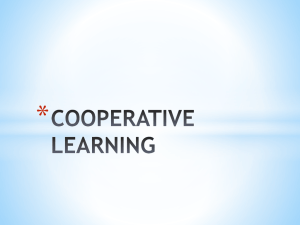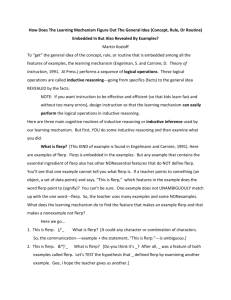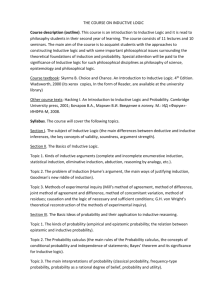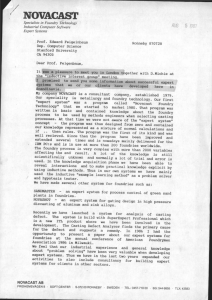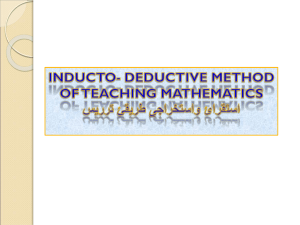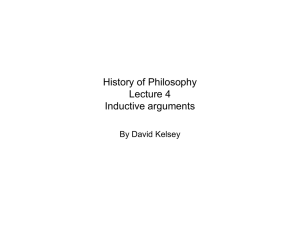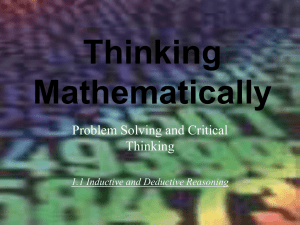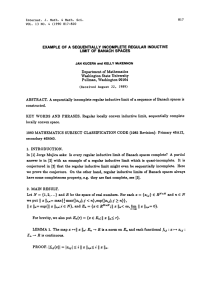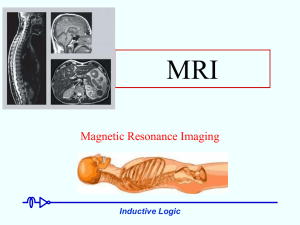Inductive Model Prese
advertisement
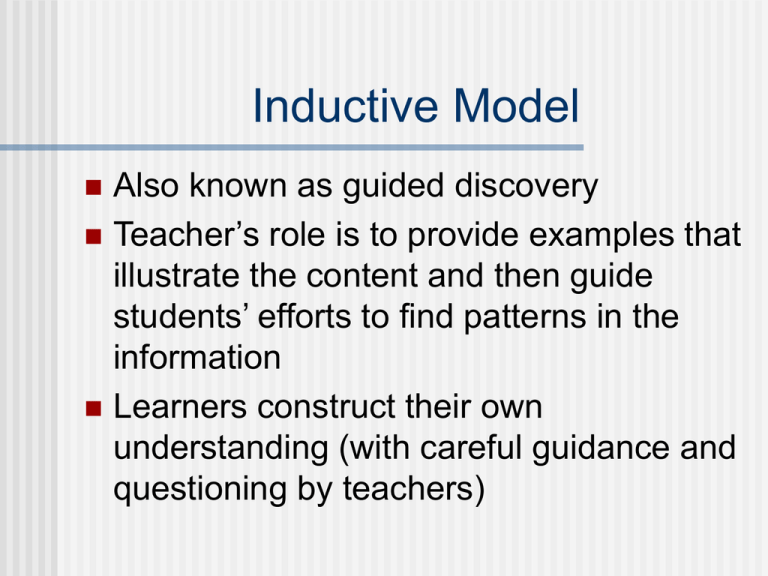
Inductive Model Also known as guided discovery Teacher’s role is to provide examples that illustrate the content and then guide students’ efforts to find patterns in the information Learners construct their own understanding (with careful guidance and questioning by teachers) Sample Lessons Judy Nelson’s longitude and latitude Sue Grant’s behavior of gases Jim Rooney’s rules for punctuating singular and plural possessive nouns An Overview Each topic was specific and well defined Each teacher presented chosen examples and then guided the students as they formed their conclusions Each teacher used a variety of teaching strategies to guide students to the correct conclusion(s) The students used basic cognitive skills to move from the examples to the conclusions Characteristics of the Inductive Model Highly sophisticated and demanding instruction Teachers must be expert in questioning Teachers must monitor behavior Teachers must make on the spot decisions about what questions to ask and which students to call on The students must be guided to analyze the information Theoretical Foundations Lessons using Inductive Model begin with and are built around examples These examples become the experiences that learner use to construct their understanding of the topic Theoretical Foundations Social interaction is used to analyze the examples. Social interaction and teacher guidance will help eliminate misinterpretation of the examples Theoretical Foundations The teacher guides the students. It is a dual role: (1) accepting and honoring the students’ “inventions” of knowledge (even when they are wrong) while at the same time (2) guiding the students toward a more mature understanding Concepts Categories with common characteristics Mental categories, sets, or classes Latitude is a concept Rectangle is a concept Perspective in art is a concept The number of concepts in the school curriculum is nearly endless A Concept’s Characteristics A concept’s characteristics are its defining features Example: Rectangle Common Characteristics • Opposite sides equal in length • Opposite sides parallel • All interior angles are 90 degrees Some Concepts are “Fuzzy” Example: Cars Best to present a “fuzzy” concept using either prototypes or exemplars Prototypes are the best representatives of its class Exemplars are the most highly typical members of its class. USA: prototype of democracy CAR: exemplars are Ford Taurus, Toyota Camry Concept Analysis It includes the following: Definition Characteristics Examples Superordinate concept (larger category) Subordinate concept (subsets of the concept) Coordinate concept (related subset of the superordinate category) Example: Adjective Definition: part of speech, modifies a noun Characteristics: modifies a noun Examples: old car, exciting game, home team Superordinate concept: parts of speech Subordinate concept: Predicate adj. Coordinate concept: Adverb The Keys to Making Concepts Understandable A clear definition Carefully selected examples Carefully selected nonexamples Relationships among Concepts Principals: relationships among concepts accepted as valid for all known cases Principles are also known as laws Example: All like magnetic poles repel, unlike magnetic poles attract Relationships among Concepts Generalizations: general patterns with known exceptions Example: a daily dose of aspirin reduces the danger of a heart attack This is generally accepted as good medical practice, but there are exceptions for certain medical conditions Relationships among Concepts Academic rules: relationships between concepts arbitrarily derived by people Example: Rounding The rule is: Round up a number if the last digit is 5 or higher We could have set the last digit at 6 or higher, we have arbitrarily set it at 5 or higher Planning Lessons with the Inductive Model Identify topic Specify learning objective(s) Identify examples and nonexamples Use quality examples Use a variety of examples Use real world examples Use concrete materials Use pictures Use models Use vignettes (case studies) Use technology and computer software Implementing Lessons Using the Inductive Model Phase 1: Introduction The focus of the lesson is established The teacher attracts students’ attention The teacher activates curiosity and motivates students Poses a problem to solve Reviews previous material on subject Implementing Cont. Phase 2: The open-ended phase Students make observations and comparisons that are used for further analysis With examples and nonexamples Teacher promotes involvement by asking open-ended questions Teacher ensures success Implementing Cont. Phase 3: The convergent phase Teacher narrows the range of student responses and assists them in identifying the essential characteristics of a concept, or guides students to a generalization, principle, or academic rule Implementing Cont. Phase 4: Closure Students summarize or state correct conclusions Implementing Cont. Phase 5: Application To insure transfer, students must be able to apply their knowledge outside the classroom Teachers provide opportunities for students to relate the topic to the real world Independent seatwork Homework Teachers link new knowledge to previously learned knowledge Characteristics of Inductive Model Emphasizes critical, higher-order thinking Increases student motivation Learner involvement and success Evokes curiosity and challenges students to find an “unknown” Examples provide background information to accommodate individual differences Creative model peaks student interest Assessing Student Learning Assessment must match teacher objectives You can use: Traditional paper and pencil assessments Assessments that capitalize on real world contexts

